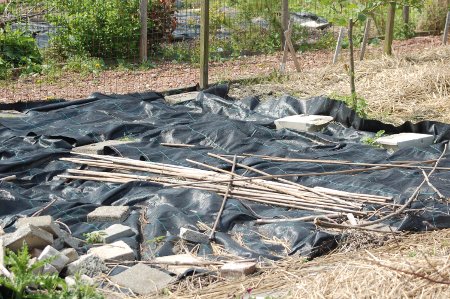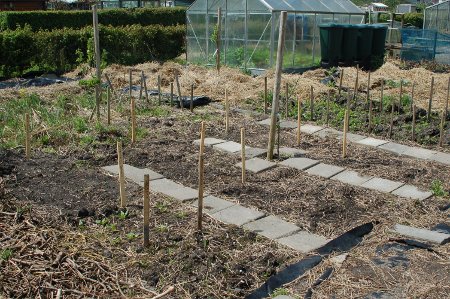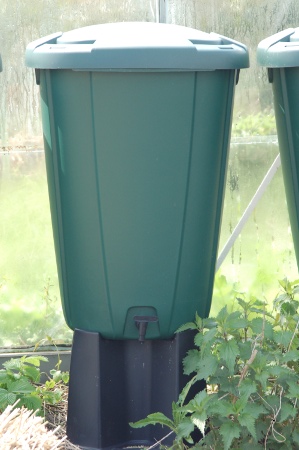Okay, it’s the time of year where a lot of people are trying to figure these things out, so I thought I would make a post. I’m pretty sure I’ve covered all these things before, but it’s the nature of blogs that things scroll off the front page and get lost, so it’s probably a good idea to say it all again.
Mulching
Christopher and Rosemary made a post recently about this, with lots of great information. I’m just going to add a few things to what they already said.
In terms of controlling weeds, there are two main mulching techniques, sheet mulching and using material high in carbon. In case of the former the idea is to smother the weeds, and the latter is to create a chemical reaction between carbon (C) and nitrogen (N).
C and N are everywhere in the garden, and all composting and rotting is a reaction between these two elements. Dry brown plant materials are high in C, and green plant materials and manures are high in N. In addition there’s N present everywhere in the air, and it’s an essential nutrient in the ground. All plant and animal life depends on N.
When you put high C mulch on the ground and it starts to rot, it needs N from somewhere, and it tends to take it out of the top 2 or so centimeters (roughly 1″) of the ground. Because it makes the surface layer of the garden soil N poor, it makes it hard for plants to grow in it. Any plants with roots deeper than this can get N elsewhere in the ground, which is why you can place mulch around established plants.
After mulch rots, it releases the N into the ground again, so there is no net loss of N in your garden. You do not need to add extra N to make up for any loss of N, because none is lost.
If you want to use mulch to kill established plants with roots deeper than a few centimeters, normally you use some sort of sheet mulch. In my garden I use plastic, what in Europe is usually called ground cloth and in the US I think is usually called landscape fabric. Probably most people reading this know what I’m talking about. It’s a reusable woven plastic material, often with green or orange lines, that lets water and air pass through it but blocks light. In this way it destroys weeds, but not other life in the ground.
Many people use biodegradable sheet mulches like cardboard or newspaper, which can be left in place to rot as well as covered with dirt and planted into right away. Lasagna gardening can make use of this principle. I use too much sheet mulch to use something that’s not reusable, otherwise I would have to bring too many mulching materials into my garden.
As an alternative to using sheet mulching to kill established weeds, you can also use a very reactive high C material. Wood chips are an example of this. Fresh wood chips are very aggressive in removing N from whatever they come in contact with, and will generally kill established weeds. For this reason, they are normally used on paths around the garden rather than in the garden itself. It’s also important not to turn wood chips under, because they will make the ground very N-poor and difficult to grow anything.
The other thing that happens when you use mulch, which is unrelated to everything else I’ve said here, is even when weeds to manage to grow through the mulch their roots tend to come up near the surface. This generally means they can be removed with a rake or are very easy to pull out by hand.
Lasagna Gardening and Raised Beds
For no-dig/permaculture style gardening, it’s important to control the weeds with mulching techniques. There’s no such thing as a garden free of weeds! You will always have to do some weeding by hand, but you want to make your job as easy as possible.
It’s also important to keep the ground as loose as possible, so when there are weeds, they are as easy as possible to remove. This is normally best achieved by maintaining distinct layers in your garden soil, which help promote good drainage and a good home for beneficial organisms. These layers are where the idea of lasagna gardening come from.
You need not do very much special to get these layers, by simply not disturbing the soil and adding home made compost from time to time on the top of your garden beds, they will develop layers on their own.
It’s also important not to walk in your beds, in order to minimize compacting of the soil.
It’s very possible to combine the idea of sheet mulching and lasagna gardening, and Ewa recently made a post about this including a how-to video. For my purposes however, this is kind of a lot of work and it’s not always necessary. Constructing a bed like this is only necessary if you have a spot where you want to build a garden bed, that has established weeds, and you want to plant in it right away.
Raised beds, while convenient because of their height, meaning you don’t have to bend down so far, are also not always necessary. It’s also possible to make use of what Kenny calls borderless raised beds. These aren’t really raised beds at all, but rather a place in your garden you simply designate and treat as a raised bed but isn’t raised. These generally work as well or nearly as well as a true raised bed, and what I mostly use.
Unless you have recycled materials available, constructing the type of bed in Ewa’s post or a true raised bed can involve a lot of unnecessary, expensive and sometimes environmentally unfriendly materials like peat products or timber. For example raised beds are generally built with wood that if treated will leach chemicals into your garden, and otherwise will only last a few years before needing to be replaced. They can also be built with bricks or stones, but this is more work and the materials have to be brought from somewhere. In any case, raised beds are generally only worth building if you know you will use the same garden for a number of years.
My Methodology
Sheet mulching takes about 6 months to kill the plants under it, and since my garden is in continuous use, I can usually plan in advance when needing to kill an area of established weeds. I use the woven plastic material I mentioned above, and on an ongoing basis mulch parts of my garden. Any time a part of my garden becomes unused for a time, like at the beginning of winter, I make an effort to keep it covered with plastic if possible. It’s of course always better to keep something growing in the ground, like a cover crop, but this isn’t always possible.
I built a number of raised beds I posted about here. Otherwise, I make ‘borderless’ raised beds by building temporary paths with small paving stones, about 30cm or a foot square. In the picture on the top of the same post above, you can see I then use a lot of straw to control annual weeds.
Before I plant in each bed I rake any straw that may remain from the previous year to the side, loosen the ground a little bit with a digging fork, then plant directly into it. Some of the beds also get some added compost.
The whole process in the spring of first removing the plastic mulch from the ground, building paths with paving stones, loosening the ground with a digging fork and raking the ground clear all takes a very short time and is very little work compared with digging weeds out every year like the other gardeners in my community garden do. I’ll try to post some pictures of this sometime, so you can see better what I’m talking about.







